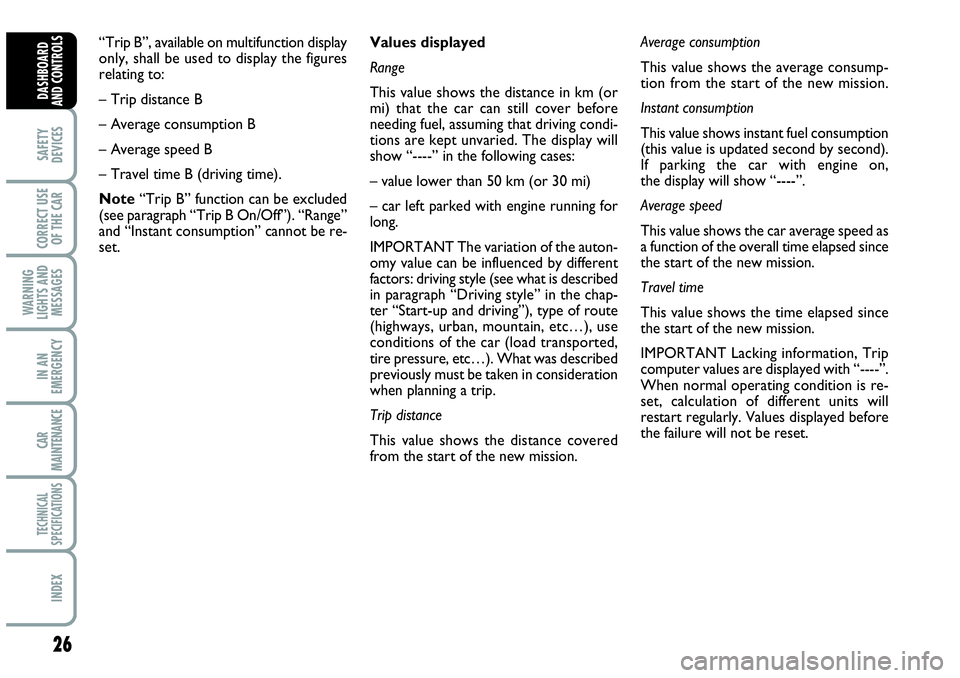2007 Abarth Grande Punto fuel type
[x] Cancel search: fuel typePage 16 of 207

14
SAFETY
DEVICES
CORRECT USE
OF THE CAR
WARNING
LIGHTS AND
MESSAGES
IN AN
EMERGENCY
CAR
MAINTENANCE
TECHNICAL
SPECIFICATIONS
INDEX
DASHBOARD
AND CONTROLS
INSTRUMENTS
Instrument background color and type
may vary according to the version.
SPEEDOMETER fig. 12
It shows the engine speed.REV. COUNTER fig. 13
Rev counter shows engine rpm.
IMPORTANT The electronic injection
control system gradually shuts off the flow
of fuel when the engine is “over-revving”
resulting in a gradual loss of engine pow-
er.
When the engine is idling, the rev counter
may indicate a gradual or sudden higher-
ing of the speed.
This is normal as it takes place during nor-
mal operation, for example when activat-
ing the climate control system or the fan.
In particular a slow change in the speed
preserves the battery charge.
fig. 12F0M002Abfig. 13F0M003Ab
Page 28 of 207

26
SAFETY
DEVICES
CORRECT USE
OF THE CAR
WARNING
LIGHTS AND
MESSAGES
IN AN
EMERGENCY
CAR
MAINTENANCE
TECHNICAL
SPECIFICATIONS
INDEX
DASHBOARD
AND CONTROLS
“Trip B”, available on multifunction display
only, shall be used to display the figures
relating to:
– Trip distance B
– Average consumption B
– Average speed B
– Travel time B (driving time).
Note“Trip B” function can be excluded
(see paragraph “Trip B On/Off”). “Range”
and “Instant consumption” cannot be re-
set.Average consumption
This value shows the average consump-
tion from the start of the new mission.
Instant consumption
This value shows instant fuel consumption
(this value is updated second by second).
If parking the car with engine on,
the display will show “----”.
Average speed
This value shows the car average speed as
a function of the overall time elapsed since
the start of the new mission.
Travel time
This value shows the time elapsed since
the start of the new mission.
IMPORTANT Lacking information, Trip
computer values are displayed with “----”.
When normal operating condition is re-
set, calculation of different units will
restart regularly. Values displayed before
the failure will not be reset. Values displayed
Range
This value shows the distance in km (or
mi) that the car can still cover before
needing fuel, assuming that driving condi-
tions are kept unvaried. The display will
show “----” in the following cases:
– value lower than 50 km (or 30 mi)
– car left parked with engine running for
long.
IMPORTANT The variation of the auton-
omy value can be influenced by different
factors: driving style (see what is described
in paragraph “Driving style” in the chap-
ter “Start-up and driving”), type of route
(highways, urban, mountain, etc…), use
conditions of the car (load transported,
tire pressure, etc…). What was described
previously must be taken in consideration
when planning a trip.
Trip distance
This value shows the distance covered
from the start of the new mission.
Page 197 of 207

195
WARNING
LIGHTS AND
MESSAGES
INDEX
DASHBOARD
AND CONTROLS
SAFETY
DEVICES
CORRECT USE
OF THE CAR
IN AN
EMERGENCY
CAR
MAINTENANCE
TECHNICAL
SPECIFICATIONS
Fuel consumption according to Directive 1999/100/EC (litres x 100 km)
Versions Urban Extra-urban Combined
1.4 T-JET9,6 5,3 6,9
❒extra-urban cycle: frequent accelerat-
ing in all gears, simulating extraurban
use of the car: speed varies between 0
and 120 km/h;
❒combined consumption: is calculated
weighing about 37% of urban cycle con-
sumption and about 63% of extraurban
consumption.
FUEL
CONSUMPTION
The fuel consumption figures given in the
table below are determined on the basis
of the homologation tests set down by
specific European Directives.
The procedures below are followed for
measuring consumption:
❒urban cycle: cold starting followed by
driving that simulates urban use of the
car;IMPORTANT The type of route, traffic
situations, weather conditions, driving
style, general conditions of the car, trim
level/equipment/accessories, load, climate
control system, roof rack, other situations
that affect air drag may lead to different
fuel consumption levels than those mea-
sured.
Page 199 of 207

197
WARNING
LIGHTS AND
MESSAGES
DASHBOARD
AND CONTROLS
SAFETY
DEVICES
CORRECT USE
OF THE CAR
IN AN
EMERGENCY
CAR
MAINTENANCE
TECHNICAL
SPECIFICATIONS
INDEX
– version codes ............................... 184
Bonnet .................................................. 71
Boot ........................................................ 68
– extension ........................................ 69
– tailgate opening/closing ............... 68
– emergency opening....................... 69
Boot light .............................................. 55
Brake Assist (brake assist
in an emergency)............................... 78
Brakes
– fluid level ........................................ 169
– technical data ................................ 186
Bulb (replacement)
– general instructions ..................... 139
– types of bulbs ................................ 139
Car inactivity ...................................... 120
Car maintenance
– periodical checks........................... 165
– scheduled servicing ...................... 162
– service schedule ........................... 163
– use of the car under heavy
conditions ........................................... 165Card box - CD box............................. 60
Carrying children safely ..................... 97
Ceiling lights
– front ................................................ 54
– puddle/door .................................. 55
Central console oddment
compartment ..................................... 58
Child restraint systems
– “Universal Isofix” ......................... 102
Cigar lighter .......................................... 60
Clutch ................................................... 185
CO
2emissions...................................... 196
Code Card ........................................... 8
Consumption
– engine oil ........................................ 167
– fuel ................................................... 195
Control buttons .................................. 55
Correct use of the car ...................... 127
Cruise Control ..................................... 52
Digital display ..................................... 16
Dimensions .......................................... 190
ABS ...................................................... 76
Accessories purchased
by the owner .................................... 88
Air bag
– front ................................................. 103
– side .................................................. 106
Air filter ................................................ 170
Air vents ............................................... 34
Alarm...................................................... 11
Armrest................................................. 59
Ashtray................................................... 60
ASR ......................................................... 81
– activation/deactivation ................. 82
Automatic two-zone climate
control system .................................. 40
Battery
– checking the charge ..................... 171
– jump starting ................................. 134
– recharging ...................................... 157
Bodywork
– maintenance .................................. 176
I I
N N
D D
E E
X X